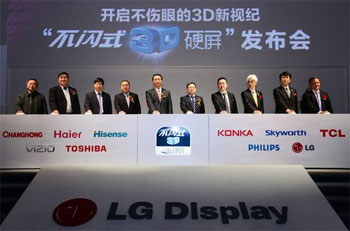For those unfamiliar, interlaced polarized displays work by vibrating light at two different wavelengths, and have the 3D glasses filter the images to the left and right eye independently. This offers a bright image with little to no ghosting or cross-talk.
I don't think interlaced polarized displays vibrate light at two differents wavelength, they are generally standard displays minus certain filters and an added one that is interlaced with a different polarization on alternate lines. They also produce more ghosting than Plasma or DLP TV/projectors, so the "little to no ghosting" quote is a pretty great stretch of the reality. Maybe a verbatim excerpt from a PR communication by LG...
For stereoscopic 3D gamers and game developers, polarized solutions offer additional benefits that most aren't aware of:
First, while the HDMI 1.4 specification used with modern 3D HDTVs is supposed to support 1080P at 60 frames per second in 3D mode, this is beyond the capability of current chipsets. For gamers, most 3D HDTVs with shutter glasses are limited to 720P resolution at 60FPS, and 1080P is capped at 24FPS.
I don't see the alledged benefit of passive solutions in this case, the resolution is still halved compared to full HD. In interlaced mode you've got 1,036,800 pixels per eye at 60Hz (1920x1080 / 2), still better than 720p with HDMI 1.4 (921,600 pixels per eye at 60Hz) but the same than side-by-side or above-and-below HDMI 1.4 modes in 1080p.
Another benefit is the interface itself. While HDMI 1.4 is a standard connector, there is some secrecy in how it is accessed. This is why HDMI 1.4 compliance is only possible with Nvidia stereo drivers on Nvidia GPUs (3DTV Play), and DDD and iZ3D can only accomplish the same results through AMD graphics cards. In the case of interlaced polarized displays, game developers can write directly to the screen without any special pass-through with proprietary display drivers.
I don't think it's true either, although the HDMI 1.4 specifications are only available to HDMI adopters, the updated 3D portion of the norm is
available for public download.
I also think that the frame packing mode in 1080p can be easily implemented by anyone by simply creating a 1920x2205 graphics mode and rendering stereo images in above-and-below format with an horizontal 45 pixels black bar in between. I know someone who tested this with his 3D TV plugged to his PC, and the 3D mode got activated on the TV.
What does this gobbledygook all mean? Whether you are using a passive display or a shutter glasses display, there are still ways to get 1080P output and have direct access to the screen at 60FPS regardless of HDMI 1.4 compliance.
That's not the case, although the image is displayed in 1080p at 60Hz per eye it's not really 1080p since the pixel information is halved.
The solution is to either change the entire standard to an above/below format so that interlaced displays aren't disadvantaged, or for the industry to quickly choose and implement a compression format like those offered by Sensio and TDVision Corp.
Changing to above/below format won't make interlaced solutions compatible, the image itself must also be modified so that the lines are not consecutives (L1, L3, L5, ..., R2, R4, R5,... instead of L1, L2, L3, ..., R1, R2, R3, ...). And with this arrangement active solutions wouldn't be compatible any longer since they would loose information in each image and produce aliasing artefacts.
The Sensio format won't be appropriate for interlaced displays either, it's basically a checkerboard format so it would make more sense for active displays, but unfortunately most of them don't support checkerboard.
Other problems related to passive displays that have not been cited in the article (apart from the halved resolution) is the fact that black lines are clearly visible at normal viewing distances (
less than 3m from a LG 47" display) and that the angles of vision are extremly limited and produce even greater ghosting when your head is not centered relatively to the screen (both horizontally and vertically).

